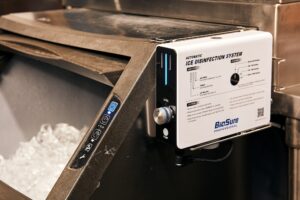Ozonated water has become an invaluable tool for a number of businesses. With any emerging technology, there are always concerns about safety and potential harm to humans. Ozone has proven to be a powerful disinfection technology used for over a hundred years to keep us safe from infections from bacteria and viruses. Those with concerns that ozone is harmful to humans can keep reading to learn about the many benefits of ozone across a number of industries, particularly compared to the use of chemical disinfection agents.
Ozonated water is one of the most effective sanitation solutions on the market. Recent advancements in electrolytic ozone technology have made ozone even more accessible by allowing the generating of ozonated water at higher concentrations with smaller machines that can fit in compact spaces. Ozone technology is used across a variety of industries, with applications for healthcare, food safety and sanitation, beverage, dentistry, professional laundry, and professional cleaning.
For example, ozonated water can kill bacteria on surfaces of kitchen counters and food prep stations. It’s commonly used to disinfect fish, meat, vegetables, and poultry by removing bacteria and pathogens through a wash with ozonated water. It’s also effective at removing odors from mildew in washing machines and disinfecting dental water units.
Ozone leaves no chemical residue
Thanks to the ozone’s short half-life of an average of 15 minutes, it dissipates into oxygen after disinfection. This means if you were to disinfect a room with ozone mist, after twenty minutes there wouldn’t be any trace of ozone left, unlike chlorine. This is because ozone is unstable and reverts back to oxygen (O2). Research by the world recognized laboratory Campden BRI backs up these claims. Trials undertaken in 2014 found that ozone at the right concentrations and contact times can be an effective environmental disinfectant and when used correctly, causes no adverse effects after disinfection.
How ozone disinfects
We might be familiar with ozone in our atmosphere. But ozone can be generated on-demand as well. Ozone is highly reactive and attracts electrons from other compounds. It oxidizes — a process where it undergoes a reaction in which electrons are lost — drastically reducing the biological integrity of anything it attacks. Ozone ruptures the cellular walls of bacteria causing the cells to break down and so there’s no chance for the biological organism to build up immunity, unlike chemical disinfectants. Ozone can oxidize certain minerals as well, removing manganese and iron out of drinking water.
It disinfects surfaces
Ozonated water has been a blessing for the food and beverage and healthcare industries. In central kitchens and restaurant food prep stations, bacteria collect on surfaces that are used to prepare food. Some hotel chains and large restaurants require multiple food prep stations to handle a large number of customers. This makes it a challenge for kitchen staff to use chlorine to disinfect these food prep surfaces every night. For one, the storage of enough chlorine to disinfect every food prep station on a daily basis uses valuable facility space. Secondly, mixing the chlorine disinfection solution is prone to human error, especially if employees do not undergo proper training. With ozone, kitchen staff can simply spray ozonated water via an ozone spray bottle on surfaces, and rid them of bacteria by simply wiping them down, saving time, money, and hassle.
Is Ozone harmful for humans?
Ozonated water made through electrolytic ozone generators is safe for humans. The US and Europe have strict indoor ozone safety standards. If exposure is controlled, there are no safety issues. However, ozonated gas generated through the corona discharge methods does bring safety concerns. When inhaled, ozone gas can damage lungs, and relatively low amounts can cause chest pain, coughing, shortness of breath, and throat irritation. Ozone may also have negative effects on people with respiratory conditions such as asthma and affect their ability to fight respiratory infections.
Compared to the long term effects of using chlorine for disinfection, ozone is safer. Chlorine is a chemical disinfection agent that has drawbacks for both humans and the environment. Long-term exposure to low levels of chlorine gas is potentially linked to lung disease, including bronchitis, shortness of breath, possibly permanent damage, as well as tooth corrosion. Chlorine is also a comparatively weaker disinfection agent, offering relatively low protection against protozoa. On top of this, chlorine has lower disinfection effectiveness in turbid water, leaves a bad taste and odor, and is subject to human error when mixing the solution. This can lead to dangerous outcomes and often leads to using unsafe amounts.
Ozone is your friend
Ozone is not to be feared. There is a myriad of benefits from ozonated water technology. While there are guidelines to follow for the safe and proper use of ozone, the benefits of ozonated water and electrolytic ozone technology far outweigh these concerns. Business owners are realizing this and are starting to replace chemical disinfection processes with ozone water at record numbers, due to both the overwhelming effectiveness and its benefits for the environment.
BES Group is one of the leading ozonated water manufactures. With numerous patents for revolutionary electrolytic ozone technology, BES Group ozone generators produce higher concentrations of ozonated water through compact devices that can be installed almost anywhere. With recent reports that ozonated water can kill Covid-19, ozone is now making a comeback in helping keep people safe from infection. Ozonated water is particularly important in businesses that fall into high-risk categories for Covid-19 infection, such as nursing homes, hospitals, and bars. Click here to learn more.
Copyright besgroups.com All Rights Reserved
Related Articles
What is Ozone Water?
Is Ozone Water Safe?
How Ozonated Water Works?
Advantages of Electrolytic Ozone



